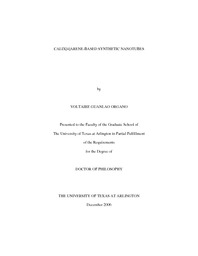
ATTENTION: The works hosted here are being migrated to a new repository that will consolidate resources, improve discoverability, and better show UTA's research impact on the global community. We will update authors as the migration progresses. Please see MavMatrix for more information.
Show simple item record
| dc.contributor.author | Organo, Voltaire Guanlao | en_US |
| dc.date.accessioned | 2007-08-23T01:56:49Z | |
| dc.date.available | 2007-08-23T01:56:49Z | |
| dc.date.issued | 2007-08-23T01:56:49Z | |
| dc.date.submitted | December 2006 | en_US |
| dc.identifier.other | DISS-1593 | en_US |
| dc.identifier.uri | http://hdl.handle.net/10106/470 | |
| dc.description.abstract | Nanoscale science and technology represents a tremendous opportunity to gain unprecedented insight into the unique phenomena that exists at the nanometer scale, and to use that knowledge to develop materials and devices with novel characteristics. This dissertation explores the unique properties of calix[4]arene-based synthetic nanotubes, the process of filling and characteristics of materials confined in one dimension.
Chapter 1 provides an overview of recently developed nanoscale materials, particularly single-walled carbon nanotubes and their ability to encapsulate materials in a one-dimensional configuration. Molecules inside carbon nanotubes are reported to exhibit structural and dynamic properties that are not observed in the bulk. Approaches are also discussed towards synthetic nanotubes as a supplement to carbon nanotubes.
Chapter 2 deals with calix[4]arenes as building blocks for constructing nanotubes. Multiple calix[4]arenes in the 1,3-alternate conformation are covalently connected to build robust synthetic nanotubes using conventional organic chemistry protocols. The dimensions of the nanotubes are controlled precisely and easily. They effectively pack into infinite tubular bundles in the solid state.
In Chapter 3, the calix[4]arene-based nanotubes are filled with multiple NO+ guests. They exhibit typical properties of calix[4]arene-NO+ complexes as evidenced by UV-vis, 1H NMR and FTIR spectroscopy. The stoichiometry of the complexes reveals the encapsulation of one NO+ guest per calixarene cavity. NO+ guests are entrapped deep inside the nanotube tunnel and experience strong electron donor-acceptor interactions.
In Chapter 4, the dynamics of the filling material inside calix[4]arene nanotubes are discussed. The tunnel of the nanotube allows the NO+ guests to freely rotate along the N-O axis and also tumble within the cavity at room temperature. Though the filled nanotube is stable, it allows the release and re-entry of guests within its hollow structure. NO+ can be transferred to and from another host such as 18-crown-6. The guest exchange and dynamics are monitored by conventional spectroscopic techniques. | en_US |
| dc.description.sponsorship | Rudkevich, Dmitry | en_US |
| dc.language.iso | EN | en_US |
| dc.publisher | Chemistry & Biochemistry | en_US |
| dc.title | Calix[4]arene-based Synthetic Nanotubes | en_US |
| dc.type | Ph.D. | en_US |
| dc.contributor.committeeChair | Rudkevich, Dmitry | en_US |
| dc.degree.department | Chemistry & Biochemistry | en_US |
| dc.degree.discipline | Chemistry & Biochemistry | en_US |
| dc.degree.grantor | University of Texas at Arlington | en_US |
| dc.degree.level | doctoral | en_US |
| dc.degree.name | Ph.D. | en_US |
| dc.identifier.externalLink | https://www.uta.edu/ra/real/editprofile.php?onlyview=1&pid=37 | |
| dc.identifier.externalLinkDescription | Link to Research Profiles | |
Files in this item
- Name:
- umi-uta-1593.pdf
- Size:
- 10.57Mb
- Format:
- PDF
This item appears in the following Collection(s)
Show simple item record


